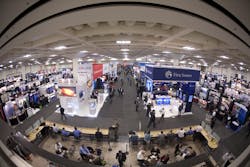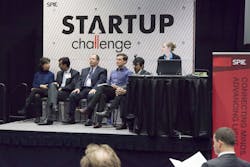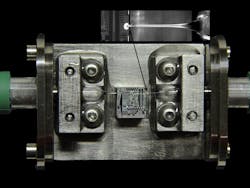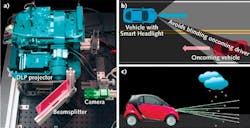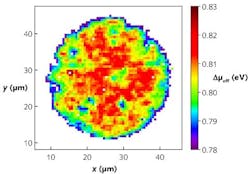PHOTONICS WEST PREVIEW: Bigger than ever, SPIE Photonics West 2014 offers technologies, products, and new opportunities across the spectrum
Every year, SPIE Photonics West presents a rewarding brew of products, market insights, and enlightening technical sessions. North America’s leading optics and photonics conference and exhibition will again be held in the Moscone Convention Center in San Francisco—this year from February 1–6. The BiOS exhibition, with some 230 exhibitors, runs from February 1–2, and the SPIE Photonics West exhibition, with 1300 exhibitors, is open from February 4–6 (see Frontis).
The mainstay symposia remain BiOS, LASE, MOEMS-MEMS, OPTO, and the virtual Green Photonics. This year, a new virtual Translation Research symposium and additional sessions on technology transfer have been added. As a bonus, there are even more special Industry Events and Special Forums and Events, where you can hear prestigious panel members in forums on Silicon Photonics and Photonic Integrated Circuits, Green Photonics: a Solar Revolution, and the always popular Executive Perspectives on the World of Optics and Photonics.
Other Industry Events include the potential to win $10,000 in the SPIE Startup Challenge on Wednesday, February 6, from 3:30 to 6 pm. In past years, it has been heavily weighted to biomedical optics, and it gives venture capital exposure and mentoring to aspiring entrepreneurs working to bring new photonics products to market (see Fig. 1). And there is a gala dinner on Wednesday evening, where the winners of the annual PRISM Awards for innovative products will be announced—the list of finalists may be found at http://www.photonicsprismaward.com/finalists.aspx.BiOS
The Biomedical Optics Symposium (BiOS) and BiOS Expo are the world's largest annual biomedical optics and biophotonics symposium and exhibition. Of the approximately 4800 papers to be presented at SPIE Photonics West, 2000 will comprise BiOS, which in turn is broken into five tracks: Photonic Therapeutics and Diagnostics; Clinical Technologies and Systems; Tissue Optics, Laser-Tissue Interaction, and Tissue Engineering; Biomedical Spectroscopy, Microscopy, and Imaging; and Nano/Biophotonics.
The latter will feature its own plenary, given by Min Gu of Swinburne University. But the major BiOS plenary, Hot Topics, will take place as usual on Saturday from 7–9 pm. During this popular session, SPIE President H. Philip Stahl will announce the winners of both the Biophotonics Technology Innovator Award and the Britton Chance Biomedical Optics Award. Then, eight carefully chosen presenters will speak:
Bruce Tromberg of the Beckman Laser Institute and Medical Clinic, University of California, Irvine, will discuss diffuse optical methods for assessing breast cancer chemotherapy; while Eric Seibel of the University of Washington will explain scanning fiber endoscopy. Optical coherence tomography (OCT) pioneer Eric Swanson of OCT News will report on research, funding, and entrepreneurism in clinical translation of OCT. Then, David Boas of Massachusetts General Hospital will describe optical spectroscopy and tomography of oxygen delivery, and Lihong Wang at Washington University in St. Louis will demonstrate the advantages of photoacoustic tomography.
Stanford University's Jelena Vuckovic will focus her talk on single-cell photonic nanocavity probes. And two speakers will address neuroscience: Paul Selvin of the University of Illinois at Urbana-Champaign will report on quantum dots for this application, while Rafael Yuste of Columbia University, a pioneer behind the U.S.’s Brain Research through Advancing Innovative Neurotechnologies (BRAIN) initiative will explain how and why optical imaging is key for neuroscience.
Three conferences will focus on the brain—particularly the application of new imaging techniques—while a new conference will cover optical elastography and tissue biomechanics.
SPIE will also introduce a new virtual symposium on translational research—a Sunday lunchtime event chaired by Bruce Tromberg and featuring 200 papers on technologies, tools, and devices with high potential for clinical use. In addition, new panels will cover investing in healthcare ventures and financing startups, and anniversary celebrations will commemorate the 45th anniversary of the discovery of supercontinuum generation and the 25th anniversary of the conference on laser-tissue interaction.
Among the week’s related social events is the first-come, first-served BiOS student networking “lunch with the experts” on Sunday at 12:30, which will feature veterans willing to discuss careers in biomedical optics. Sunday at 5 pm will feature a can’t-miss presentation on FDA policies and procedures chaired by Warren Grundfest of University of California, Los Angeles. The BiOS interactive poster sessions will run Saturday and Sunday, 3–4 pm, and Sunday, Monday, and Tuesday, early evening. Then, Tuesday evening will feature a session titled Biophotonics in Brazil: Opportunities and Research; a meeting of the the International Biomedical Optics Society (IBOS) will follow, with a presentation by Harvard University’s Sunney Xie on Label free vibrational imaging for biology and medicine.
As if that were not enough, professional development courses providing CEU accreditation will cover essential topics in biomedical engineering.
OPTO
The OPTO plenary session, held Tuesday morning, February 4, includes two especially interesting talks, one by Michal Lipson of Cornell University on pushing the boundaries of silicon photonics, and a second by Ursula Keller of ETH Zurich describing the high-average-power performance of ultrafast thin-disk lasers. Lipson has numerous patents on micron-sized on-chip photonic devices including gigahertz silicon modulators; Keller is a director of the Swiss national research program called the National Center of Competence in Research, Molecular Ultrafast Science and Technology (NCCR MUST).
In addition to a thorough coverage of photonic integration, the OPTO technical sessions will highlight advances in optoelectronic materials and devices, semiconductor lasers and LEDs, nanotechnology, quantum applications, displays and holography, and optical communications. The devices and systems presented cover the electromagnetic spectrum from millimeter waves to the ultraviolet, and from basic science to fully developed commercial devices.
Silicon photonics gets detailed coverage, with a group of U.S. and Singaporean researchers discussing the development of a compact, low-loss silicon waveguide crossing for O-band (1260–1360 nm) optical interconnects (8990-1) and researchers at Chiral Photonics describing, in an invited paper, a new generation of ultra-dense optical input and output (I/O) configurations for silicon photonics (8990-5; see Fig. 2).Germanium quantum-well optical interconnects on bulk silicon will be discussed by a team of French and Italian researchers (8990-17; February 3); the integration of germanium active and passive devices on silicon is an active topic, as evidenced by an invited paper on GeSi waveguide photodetectors and avalanche photodetectors, given by a group from Taiwan and Intel (8990-38).
The topic of LED efficiency droop (a dropoff in LED efficiency at higher currents) is extremely important in the world of LED lighting. An invited paper by a group at the University of Kassel (Kassel, Germany) covers Auger carrier leakage in gallium nitride (GaN)-based LEDs (8986-61), while researchers from the University of California, Santa Barbara discuss their experimental findings (9003-35).
Emerging display technologies are highlighted as well, with Kenneth Li from Wavien discussing a high-power laser-phosphor light source with liquid cooling intended for digital cinema (9005-6; February 6); a group from the University of Southern California describing a full-color reflective display based on high-contrast dielectric gratings (9005-6; February 6); and researchers from CREOL, The College of Optics and Photonics giving an invited paper on prospects for quantum-dot-based liquid-crystal displays (9005-15).
LASE
Presentations at the LASE plenary session, held on Wednesday, include a report on the European Photonics21 program given by Michael Mertin of Jenoptik; Mertin outlines the program’s roadmap and gives a perspective from the European photonics industry. Koji Sugioka, from RIKEN will discuss femtosecond-laser 3D micromachining and its applications to biochip fabrication, including microfluidic, micromechanical, microelectronic, and micro-optical components in glass. Michel Meunier of the Ecole Polytechnique de Montréal will describe a plasmonics-enhanced ultrafast-laser “multi-nanoscalpel” that can perform surgery on individual cells.
The LASE technical sessions themselves cover the essential areas of research and development, including laser-source engineering, semiconductor lasers and LEDs, application, and micro- and nanoengineering, as well as the nonlinear optics (frequency generation and conversion, and so on) necessary for many laser setups and systems.
Fiber lasers are a hot topic, with beam combination, line-narrowing techniques, applications, ultrafast, and novel fibers some of the areas of concentration. Coherent beam combining of fiber lasers is one way of achieving high power or energy with excellent beam quality; a group of German researchers describes how to approach terawatt peak powers at greater than 10 kHz repetition rates by multidimensional coherent combining of femtosecond fiber lasers (8961-5). In another form of beam combining, a group from CREOL and Nufern delve into spectral beam combination of kilowatt-class fiber lasers with reflective volume Bragg gratings (8961-5).
In a session on laser applications in microelectronics and manufacturing, Chunlei Guo of the University of Rochester gives an invited paper on laser-produced black and colored metals and their applications (8967-1), while in another invited paper, Yasuyuki Tsuboi of Osaka City University describes how to manufacture nanoporous films using plasmonic excitation of gold nanoparticles (8967-2). A team of researchers from several U.S. universities gives an invited talk on flying plasmonic nanofocusing lenses for scalable nanolithography (8967-6), a topic that could draw curious as well as interested attendees.
Laser additive manufacturing also gets its due: Weidong Huang and Xin Lin of Northwestern Polytechnical University in Xi’an, China give an invited talk on high-performance laser additive manufacturing of metal components (8970-22), while Spanish, German, and Belgian researchers discuss the capability to control laser-deposited claddings in real time with a variable laser spot size (8970-23).
MOEMS-MEMS
The MOEMS-MEMS symposium focuses on microoptoelectromechanical systems (MOEMS) and microelectromechanical systems (MEMS), with a total of nine topic areas in 2014 ranging from micromachining and microfabrication to microfluidics and medical microsystems to MEMS adaptive optics.
“MOEMS-MEMS 2014 continues to attract high-quality papers from leaders who are pushing the frontiers both of how we make MOEMS, MEMS, and microfluidic devices and how we can apply those devices in truly innovative and meaningful ways,” says David Dickensheets, MOEMS-MEMS Symposia chair and professor of Electrical and Computer Engineering at Montana State University. “Three outstanding Plenary speakers will set the tone for the conference, pushing our thinking about what’s possible: Roger Howe from Stanford University starts us thinking about nanomechanical systems [NEMS] in the CMOS world; Cornelia Denz from Westfälische Wilhelms-University Münster explores how 3D structured light fields allow us to interact with biomatter in a fluid environment; and John Rogers from the University of Illinois stretches our toolkit to include flexible materials, while taking inspiration from nature to design novel sensor platforms.”
Dickensheets continues, “Within the conferences, new materials and techniques for structuring across wide size scales—millimeters to nanometers—are recurring themes, while applications for MOEMS, MEMS, and microfluidics range from consumer electronics to smart vehicles, and from the discovery of exoplanets in the solar system to improving human health and how we humans interact with the world around us. It will be a fascinating and inspiring four days!”
A sampling of three MOEMS-MEMS papers illustrates real-world applications: “DMD-based reactive visual system design for programmable headlights,” paper 8979-25 from Srinivasa Narasimhan et al. at Carnegie Mellon University, provides an application for digital micromirror device technology for smart headlights to improve safety of night-time driving (see Fig. 3); “Rapid detection tuberculosis using droplet-based microfluidics,” paper 8976-39 from Sindy K. Y. Tang et al. at Stanford University, explains how microfluidics are being used in disease detection; and “MEMS tactile display: From fabrication to characterization,” invited paper 8975-4 from Miki Norihisa et al. from Keio University and colleagues at JST, describes a MEMS-based tactile display for Braille.Green Photonics
The Green Photonics ‘virtual’ symposium is organized around four topic areas: laser-assisted manufacturing and micro/nanofabrication, renewable energy generation (including fusion and photovoltaics), solid-state lighting and displays, and communications.
Chaired once again this year by Stephen J. Eglash, Stanford University’s executive director, Energy and Environment Affiliates Program, the Green Photonics symposium is ‘virtual’ because its more than 200 presentations are scattered throughout the BiOS, OPTO, LASE, and MOEMS-MEMS conferences and highlighted in the SPIE Photonics West program guide as having significant “green” content.
“For 2014, the overarching theme is the incredibly promising commercial opportunities for photonics,” says Eglash. “Two quick examples illustrate my point: First, the Wall Street Journal just named Rebellion Photonics its startup of the year. This company uses cameras and sensors to detect poisonous and dangerous gases on oil rigs and at refineries—part of a broader theme of the dramatic expansion of sensors in our industry.” Eglash continues, “Second, after five years of concern for the health of solar module manufacturing in the U.S., it’s now becoming clear that the solar industry is quite healthy. Companies like DuPont are making money providing technically superior proprietary materials to module manufacturers worldwide. Meanwhile, researchers are developing the next generation of disruptive materials that will increase efficiency and lower installed cost.”
“Our symposium has been blessed with an exceptional ‘grand cru’ of high-quality papers that could have paradigm-shifting impacts in photovoltaics/green photonics,” says Alex Freundlich, conference chair of the SPIE OPTO symposium on Physics, Simulation, and Photonic Engineering of Photovoltaic Devices III and associate director for research at the Center for Advanced Materials at the University of Houston.
Freundlich’s short list of the three hottest papers in his symposium includes “Group IV clathrates: synthesis, optoelectronic properties, and photovoltaic applications,” invited paper 8981-6 from Adele C. Tamboli et al. of the Colorado School of Mines; “Micrometric characterization methods of thin-film solar cells using luminescence emissions,” paper 8981-8 from Amaury Delamarre et al. of Institut de Recherche et Développement sur l'Energie Photovoltaïque, in which a contactless hyperspectral imager can be used to monitor optoelectronic property fluctuations at the micrometer scale to improve solar-cell efficiencies (see Fig. 4); and “Enhanced performance of up-conversion photovoltaic (UC-PV) devices via photonic crystals and plasmonic layers,” paper 8981-10 from Bryce S. Richards et al. of Heriot-Watt University and colleagues at the University of Bern.Heonsu Jeon of Seoul National University also recommends two papers in the Solid State Lighting and Displays conference that suit the ‘hot’ issue of green photonics: “UV-LEDs: the long road towards shorter wavelengths” from Michael Kneissl et al. of Technische Universitaet Berlin, OPTO paper 9003-25; and “A critical review of III-nitride LED efficiency droop models” from Joachim Piprek et al. of NUSOD Institute (Newark, DE), OPTO paper 9003-10.
Other special events
Now in its 26th year and always held in conjunction with SPIE Photonics West, the 2014 Lasers & Photonics Marketplace Seminar will be held Monday, February 3, at the Marriott Marquis Hotel (just a block from Moscone). Laser Focus World, Strategies Unlimited, BioOptics World, and Industrial Laser Solutions invite you to the only comprehensive qualitative and quantitative laser market seminar in the industry, with a keynote presentation this year from Drew Nelson, president of IQE, who will speak on European photonics initiatives.
A distinguished panel will discuss the state of the laser industry, including Peter Leibinger, managing partner of TRUMPF; Sri Venkat, senior vice president of Coherent; Søren Isaksen, chairman of NKT Photonics; and Martin Seifert, president of Nufern. Several other important presentations will look at markets for all lasers, plus markets for biophotonics, passive optics, laser additive manufacturing, and laser projectors.
Finally, you can kick off the week with FREE refreshments and network with your colleagues at the SPIE Photonics West conference reception on Monday, February 3, from 7-8:30 pm. Also to temp you, the Speed Networking Social and Women in Optics Panel and Roundtable are just of few more of the must-attend events to note on your smartphone or tablet with your SPIE Mobile App, to be found at spie.org/x36450.xml.

Barbara Gefvert | Editor-in-Chief, BioOptics World (2008-2020)
Barbara G. Gefvert has been a science and technology editor and writer since 1987, and served as editor in chief on multiple publications, including Sensors magazine for nearly a decade.

Gail Overton | Senior Editor (2004-2020)
Gail has more than 30 years of engineering, marketing, product management, and editorial experience in the photonics and optical communications industry. Before joining the staff at Laser Focus World in 2004, she held many product management and product marketing roles in the fiber-optics industry, most notably at Hughes (El Segundo, CA), GTE Labs (Waltham, MA), Corning (Corning, NY), Photon Kinetics (Beaverton, OR), and Newport Corporation (Irvine, CA). During her marketing career, Gail published articles in WDM Solutions and Sensors magazine and traveled internationally to conduct product and sales training. Gail received her BS degree in physics, with an emphasis in optics, from San Diego State University in San Diego, CA in May 1986.

John Wallace | Senior Technical Editor (1998-2022)
John Wallace was with Laser Focus World for nearly 25 years, retiring in late June 2022. He obtained a bachelor's degree in mechanical engineering and physics at Rutgers University and a master's in optical engineering at the University of Rochester. Before becoming an editor, John worked as an engineer at RCA, Exxon, Eastman Kodak, and GCA Corporation.

Conard Holton
Conard Holton has 25 years of science and technology editing and writing experience. He was formerly a staff member and consultant for government agencies such as the New York State Energy Research and Development Authority and the International Atomic Energy Agency, and engineering companies such as Bechtel. He joined Laser Focus World in 1997 as senior editor, becoming editor in chief of WDM Solutions, which he founded in 1999. In 2003 he joined Vision Systems Design as editor in chief, while continuing as contributing editor at Laser Focus World. Conard became editor in chief of Laser Focus World in August 2011, a role in which he served through August 2018. He then served as Editor at Large for Laser Focus World and Co-Chair of the Lasers & Photonics Marketplace Seminar from August 2018 through January 2022. He received his B.A. from the University of Pennsylvania, with additional studies at the Colorado School of Mines and Medill School of Journalism at Northwestern University.
